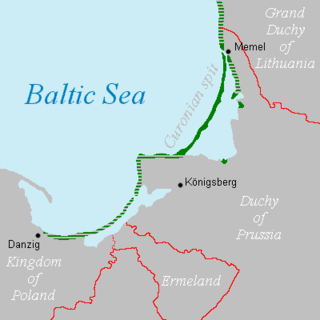Top Qs
Timeline
Chat
Perspective
Kursenieki language
Latvian dialect of the Curonian Spit From Wikipedia, the free encyclopedia
Remove ads
The Kursenieki language (Kursenieki: kursineeki wahloda; Latvian: kursenieku valoda; German: Nehrungskurisch; Lithuanian: kuršininkų kalba) or Curonian language of the Curonian isthmus (German: kurische Sprache der Kurischen Nehrung[3]) is a dialect of the Latvian language spoken by the Kursenieki of the Curonian Spit, a thin strip of land stretching between southwestern Lithuania and the Kaliningrad exclave of Russia.
This article has multiple issues. Please help improve it or discuss these issues on the talk page. (Learn how and when to remove these messages)
|
In the process of various migrations of the 14th–17th centuries, partially assimilated Curonians who were already speaking a Latvian dialect settled along the Curonian Spit in East Prussia and gradually developed a distinct identity becoming known as Kursenieki.
Remove ads
Influences and vocabulary
The Kursenieki language was influenced by Old Prussian, Low German, High German and the Samogitian language successively, and by the end of the 18th century new Curonian dialects had formed, with the dialect of the Curonian Spit being notably distinct, due to its isolation from the mainland. A Kursenieki vocabulary published in 1927 shows that 60% of Curonian words were the same as Latvian, 26% were loanwords from German (either Low German or High German), and 13% were borrowed from Lithuanian dialects. The Kursenieki language was mutually intelligible with Latvian, especially its southwestern dialects.[4]
Remove ads
History
Summarize
Perspective

Before World War II, the Kursenieki language was a sociolect of Curonian fishermen of the Curonian Spit. In other spheres of everyday life, Kursenieki used German of their surrounding environment. The events of the first half of the 20th century and the Soviet annexation of East Prussia led to the near extinction of the language, making it severely endangered. Several remaining native speakers live in Germany, having been expelled in the ethnic cleansing that took place in East Prussia after World War II.

Several pages of sample texts in Kursenieki language are included in the 1888 monograph Über die Sprache der preussischen Letten by Adalbert Bezzenberger and the 1927 monograph Kursenieku valoda by Juris Plāķis, where they describe the language spoken by the inhabitants of the Curonian Spit.[5]
There is a 2002 documentary film Tarp aštuonių vėjų ("Amidst Eight Winds") by Arvydas Barysas about the endangered Kursenieki language. The film, introducing the Curonian Spit, speaks about three brothers Sakutis (plural: Sakučiai) who had moved from the Spit to Sweden about 60 years ago, but still speak "kuršiškai".[6][7] In 2005, the film won the Best Overall Production Award at the second European Heritage Film Festival in Toblach (Italy) under the patronage of Europa Nostra.[8]
Remove ads
Phonology
Summarize
Perspective
The phonology of the Kursenieki language reflects its Baltic roots while exhibiting unique traits shaped by isolation, bilingualism, and generational variation. Key features include syllable structure, stress patterns, pitch accent, vowel behavior, diphthong dynamics, and consonantal shifts.
Syllables
Kursenieki syllables are typically closed, following Baltic phonotactic norms. Syllable length is determined by vowel quantity rather than etymology. Final unstressed syllables often shorten, and diphthongs are treated as long syllables regardless of their components. Monosyllabic forms frequently arise from vowel reduction or uninflected usage.[9]
Stress
Stress typically falls on the first syllable, inherited from Latvian dialects. Exceptions occur in compounds, loanwords, and suffixes. Personal and place names also show variable stress. These patterns reflect historical contact with Lithuanian and German, as well as internal morphological shifts.[9]
Pitch accent
Kursenieki retains a two-way pitch accent system: continuous and non-continuous. Continuous pitch is common in stressed syllables and compound words, while non-continuous pitch often appears in diphthongs and suffixes. Speaker variation affects clarity, with Lithuanian-influenced speakers articulating broken tones more distinctly. Minimal pair studies confirm the phonemic role of pitch accent, which also shifts with sentence intonation.[9]
Vocalism
The vowel system includes short, long, and semi-long vowels, along with diphthongs such as ai, au, ei, ie, ui, and uo. Long vowels may shorten in unstressed syllables, while semi-long vowels emerge through reduction. Regional traits include labialization and diphthongization, especially among Nida speakers.
Vowel system
Key features
- Short vowels: /i, e, æ, a, u/
- Long vowels: /iː, eː, æː, äː, uː/
- Semi-long vowels: [ˑ] variants in unstressed positions
- Diphthongization before /r/: e.g. /iː/ → [iə], /uː/ → [uə]
- Labialization of /äː/ to /ɔː/ in Nida speakers
- Loanword vowel /oː/ in Germanic borrowings
Diphthongs and vowel reduction
Mixed diphthongs arise from vowel reduction, especially in short syllables before endings. Long vowels in monosyllabic words may shorten depending on tempo and intonation. Secondary mixed diphthongs retain pitch accent.
In unstressed syllables, pitch accents fade, especially in suffixes. Vowel insertion (anaptyxis) occurs in clusters and after /r/, prominent in Nida speech.
Final syllables often reduce to murmured sounds or disappear, affecting noun and verb paradigms. Suffix vowels also shorten, especially in present tense verbs. Despite reduction, vowel length persists in locatives, reflexives, and tense-marked verbs.
Consonantism
Kursenieki consonants largely mirror Central Latvian, with notable divergence in palatalization and aspiration. Palatalization affects most consonant classes, especially before front vowels. Aspirated plosives (pʰ, tʰ, kʰ) appear in German-influenced speech.[9]
Palatalized forms occur contextually or phonemically. Sonants (m, n, l, r, v) show palatalized variants ([mʲ], [nʲ], [lʲ], [rʲ], [vʲ]), with speaker-dependent variation.
Consonant inventory
Remove ads
See also
References
External links
Wikiwand - on
Seamless Wikipedia browsing. On steroids.
Remove ads

